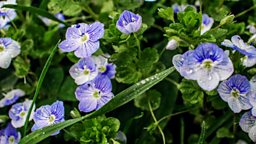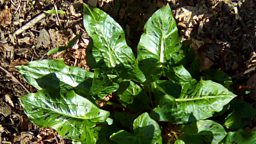12 British wild plants that tell the Easter story
In The Passion in Plants, urban naturalist Bob Gilbert and Brother Samuel, a Franciscan friar, wander our rural woodlands and the pavements of the East End to seek out the British wild plants associated with the Easter Story, from the “alleluia plant” to the “Judas tree.”

1. Goat willow
When Jesus rode into Jerusalem on a donkey, the people were said to be ecstatic, laying down their cloaks and waving fronds of palms – the symbol of royalty.
Those palms then became a significant part of the tradition of Palm Sunday processions.
-
![]()
Gardeners' Question Time
A panel of horticultural experts answer gardening questions from a live audience.
But in England, there was a problem: the palm was not a native tree. So, instead, people turned to the goat willow. The Salix caprea, (“goat willow”, “pussy willow” or “sallow”) is a rather undistinguished, woody, scrubby tree, but in March and April its silvery catkins begin to emerge, before then bursting into a bright, golden flower.
For this reason, it was the branch that was cut and carried in this country in the Palm Sunday processions. H.E. Bates states how, “It is, with the daffodil, the true Easter flower.”

2. The yew
There is another tree traditionally associated with Palm Sunday. One of our most venerable and most ancient trees: Taxus baccata, or the yew. It was used in the processions and to decorate churches, and in many parts of the country the day was even known as “Yew Sunday.”
In the South, Devon and Ireland, the yew was sometimes known as the “palm” and was burnt to make ashes for Ash Wednesday. It’s no surprise that the yew is found in more than 2,000 churchyards around Britain – but did you know that in many instances the trees were there long before the churches were built?
The yew has had a spiritual significance since pagan times. Because their branches start rooting when they reach the ground, to form new trees, they have long been connected with resurrection and eternal life.

3. Tansy
Tanacetum vulgare, or tansy, is a plant of rough grassy roadsides and hedgerows. It has very fine, feathery leaves and yellow, button-like flowers and its bitter aftertaste earned it the nickname “bitter buttons”. During lent, when people weren’t eating meat, they would eat fish instead (if they could afford it), and fish were thought to give you worms. So, they would grow and eat tansy in the hope that it’s astringency would expel any parasites!
Tansy also became to be associated with the bitter herbs of the Jewish Passover supper (or Seder) and, by extension, the Last Supper (described as a Passover meal in three of the gospels). The Jewish people eat bitter herbs as a reminder of the slavery in Egypt from which they are delivered at the Passover and the Exodus and the use of bitter plants became adopted into Easter practices too – to symbolise Judas Iscariot’s betrayal. People would make tansy cakes and puddings, and there was even an Irish tansy sausage.

4. The elder
The Sambucus nigra or elder is neither bush nor tree. On one hand it has weedy growth and smelly leaves (a scent likened to cat urine!) but, on the other, it has beautiful white flowers and a berry with all sorts of uses. This ambivalence of the tree is reflected in its folklore.
It was thought to cure anything from warts to rheumatism, and have its own protective spirit – the elder mother – whose permission you sought if you wanted to use any part of the plant. But when Christianity arrived it became associated with witchcraft: it was thought that a witch could turn herself into an elder tree.
It is also said to be the tree from which Jesus’s cross was made and from which, after the betrayal, Judas hung himself, earning it the moniker “Judas tree.” It’s even the host for a small, brown, jellylike fungus known as Auricularia auricula-judae – Latin for “the ear of Judas.”

5. The hawthorn
The hawthorn, Crataegus monogyna, gets the latter part of its name from its robust and rather painful looking barbs. The idea that the hawthorn was used to make Jesus’s crown of thorns was written about as far back as 400 AD and has become part of folklore since, all over Europe.
Just as life and death are joined in the story of The Passion, the hawthorn is thought to represent both. On the one hand, it’s associated with fertility, and the great May Day celebrations. If you washed your face in the dew of a hawthorn before dawn on 1st May it would ensure your eternal youth and good looks! But take the flowers into the home and it was thought to presage a death.
Also, its flowers give off a substance that is produced in the early stages of decomposition in animal tissue: trimethylamine. Its blossom literally smells of death. Legend has it that hawthorns were in full bloom during the plague, and their flowers absorbed the smell of the corpses lying on the streets of London.

6. Speedwell
As Christ carried his cross to Calvary he was followed by a crowd of people. Legend has it that one woman in that crowd, Veronica, took off her veil and wiped the sweat on his brow. On taking back the veil she saw the stamp of Jesus’s countenance on the cloth, and the image of Christ is said to have stayed on the cloth ever after.
There is a certain plant that serves to remind us of this story. Speedwell, or “bird's eye”, is a tiny, scrabbling plant with long stems and milky blue flowers. Its name literally means “speed thee well”, or “go safely on your journey”, perhaps because it grows by waysides and roadsides, and in Ireland it was stitched into your clothing to ensure safe travel. The Latin name given to this genus is Veronica – the association being that Veronica was helping Christ on his journey.

7. The aspen
The aspen tree’s leaves are grey-green, with a lovely scalloped edge, and, long, thin stems attaching them to the twigs. These lengthy stems mean the leaves are always shifting, shivering and trembling – a characteristic that is reflected in its scientific name: Populus tremula.
It’s one of a number of trees in folklore and tradition that has been credited with providing the wood for Jesus’s cross, and some believed it was condemned to tremble with remorse for the ignominious role that it played. In some parts of the British Isles this tree was regarded as cursed. You would have nothing of aspen in your house, or your boat, and if you passed one you would throw stones at it.

8. The cuckoo pint
Arum maculatum, also known as “cuckoo pint” or “lords-and-ladies”, has all sorts of bawdy and sexual associations in folklore, and there’s also a story about how it got its glossy, ink-black spots. Legend has it that this plant was growing at the base of the cross and splattered with the dripping blood of Christ – and still bears the stain to this day.

9. Early purple orchid
The cuckoo pint’s reputation is shared by a number of other plants, like the early purple orchid, which appears in early April until early May. Orchis mascula also has leaves that show black spots and it is known in Devon as “the cross flower.”

10. Pearlwort
Sagina procumbens, or pearlwort, is a tiny plant with little white flowers which, as it grows, bulks up to form cushions. According to Gaelic legend, as Christ rose from the dead and stepped out of the tomb, it was the pearlwort that was there to cushion his first footfall.
For this reason, the plant took on a blessed and protective role in the Scottish Highlands. A woman in childbirth would place some under her right knee to ease the pains of labour, or a lady might slip a little bit into her mouth before she kissed a man to bind him to her forever!

11. Touch-me-not balsam
Impatiens noli tanger is a rare and local plant found only in certain areas of damp woodland in North Wales or the Lake District. It is the sole food of one moth: the netted carpet moth. When the seed pods are ripe, they burst, ejecting their seeds away from the parent plant.
Its Latin name – meaning “touch-me-not” – refers to the meeting of Christ and Mary Magdelen in the garden of the resurrection, when the latter first mistook Jesus for the gardener. As she reaches out to towards him he says, “Touch me not; for I am not yet ascended to my Father.”

12. Wood sorrel
This is a spring woodland plant with tiny, clover-like leaves and a sharp, lemony flavour – like sorrel. Oxalis acetosella has many names, including “cuckoo”, “bread and cheese” and “butter and eggs”, but it has one country name for which it was best known, not just in this country but all over Europe, and that was the “alleluia plant” – because its delicate white flowers will be open for Easter Day.
Alleluia is a Hebrew word that means “praise the lord” and it’s heard in churches across the land on Easter Sunday.

More from Radio 4
-
![]()
Gardeners' Question Time
Horticultural programme featuring a group of gardening experts
-
![]()
Eight great houseplants you'll love staring at
Celebrating our chlorophyll-full companions we should all get to know.
-
![]()
Wellbeing and air purifying: the truth about houseplants
Some amazing facts about our potted pals.
-
![]()
The Food Programme: An Easter Special
Dan Saladino hears from cooks in Palermo, Marseille and Kyiv about Easter food traditions.





